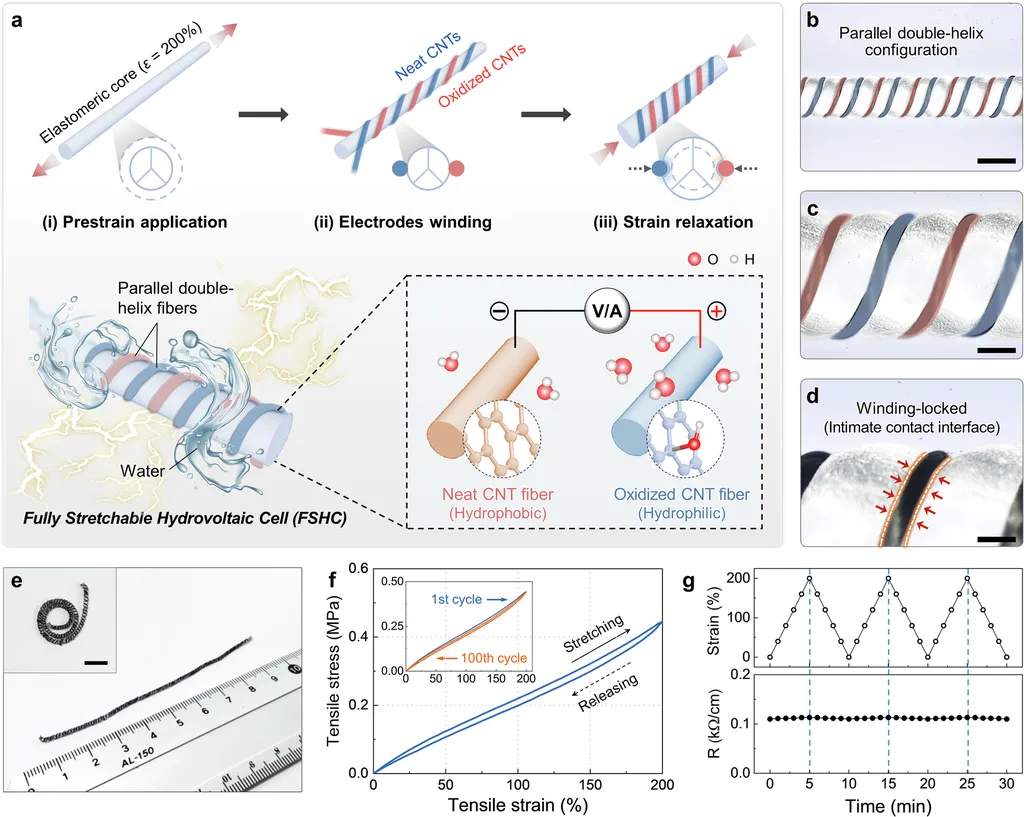In a groundbreaking development poised to reshape the energy landscape, researchers have unveiled a novel design for hydrovoltaic cells that could revolutionize wearable electronics and self-powered actuation. The study, led by Wonkyeong Son from the Department of Electronic Engineering and Biomedical Engineering at Hanyang University, introduces a fully stretchable hydrovoltaic cell (FSHC) that harnesses the interaction between water and nanomaterials to generate electricity. This innovation, detailed in the journal npj Flexible Electronics (which translates to “Flexible Electronics” in English), opens new avenues for sustainable energy harvesting and wearable technology.
The traditional hydrovoltaic power generators have been constrained by non-stretchable, planar designs that necessitate continuous water flow or ionic solutions. However, Son and her team have overcome these limitations with a unique parallel double-helix configuration of carbon nanotube (CNT) fibers wound around an elastomeric core. This winding-locked double-helix architecture not only ensures mechanical robustness but also maintains stable electrical properties even under significant strain.
“Our design allows the hydrovoltaic cell to generate electricity efficiently, even when immersed in quiescent deionized water,” explains Son. “This is a game-changer for applications where continuous water flow is not feasible.”
The FSHC generates approximately 0.31 volts and 22.4 microamperes per square centimeter, demonstrating reliable performance up to 200% strain. To showcase its potential in real-world applications, the researchers integrated the FSHC into a fabric glove, illustrating its viability for wearable electronics. Furthermore, multiple FSHCs connected in series or parallel were capable of powering a twisted CNT fiber actuator, highlighting its potential for self-powered actuation systems.
The implications of this research are far-reaching. The ability to create deformable hydrovoltaic platforms that can be integrated into wearable technology and self-powered devices represents a significant step forward in the field of energy harvesting. As Wonkyeong Son notes, “This technology could pave the way for a new generation of wearable electronics that are not only sustainable but also highly efficient and adaptable to various environments.”
The commercial impacts for the energy sector are substantial. The development of stretchable hydrovoltaic cells could lead to innovative energy solutions that are more versatile and adaptable than ever before. From powering wearable health monitors to enabling self-powered actuators in industrial settings, the potential applications are vast.
As the world continues to seek sustainable and efficient energy solutions, the work of Son and her team offers a promising path forward. By pushing the boundaries of what is possible with hydrovoltaic technology, they are shaping the future of energy harvesting and wearable electronics. The research published in npj Flexible Electronics serves as a testament to the power of innovation and the potential for transformative change in the energy sector.

